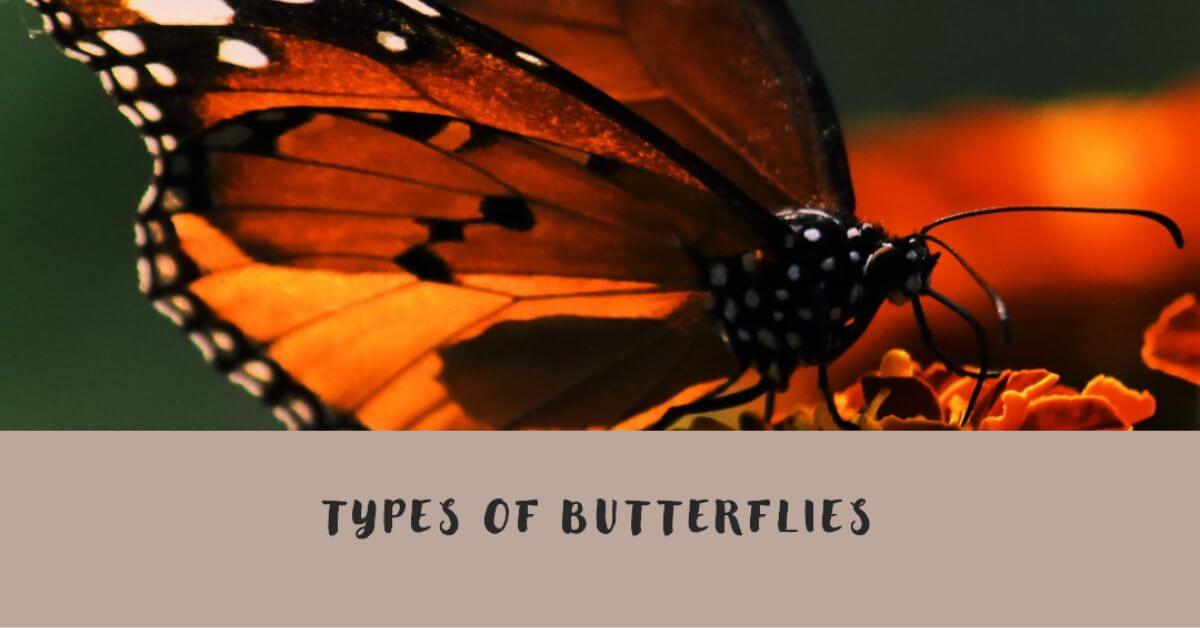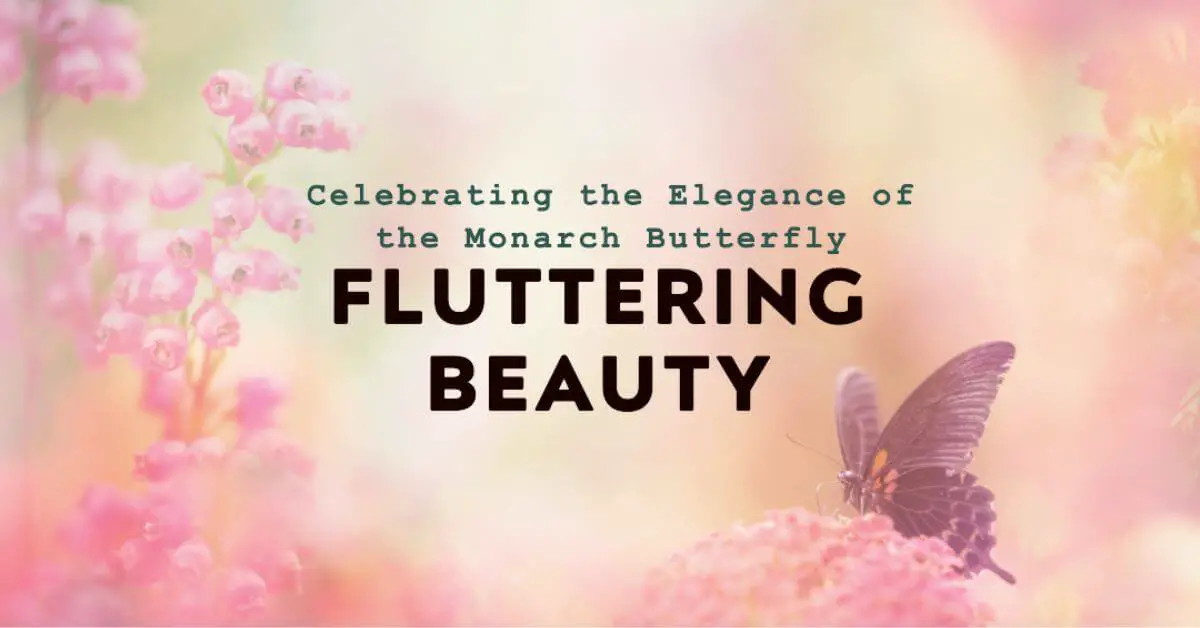Butterflies, those delicate and colourful creatures that grace our gardens and flutter through our meadows, are a true marvel of nature. Their vibrant hues and graceful flight patterns never fail to capture our attention and evoke a sense of wonder. In this comprehensive article, we embark on an exciting journey to explore the myriad types of butterflies that inhabit our planet. From the enchanting Monarchs to the elusive Swallowtails, each species has its own captivating story to tell.
Monarch Butterflies
Let’s kick off our Monarch butterfly expedition with the Monarchs, often regarded as the royalty of the butterfly world. With their distinctive orange and black wings, Monarchs are renowned for their epic migrations spanning thousands of miles across North America. These majestic wanderers embark on a remarkable journey, defying all odds as they traverse various landscapes and weather conditions.
Swallowtail Butterflies
Moving on, we encounter the Swallowtail butterflies, exemplifying graceful elegance as they glide through the air. These butterflies are easily recognized by their unique “swallowtail” extensions on their hindwings, which lend them an exquisite appearance. With species like the Tiger Swallowtail and the Black Swallowtail, these creatures add a touch of sophistication to any natural setting.
Blue Morpho Butterflies
Ah, the Blue Morphos! If there ever was a butterfly that embodied the phrase “living masterpiece,” it would undoubtedly be the Blue Morpho. Native to the rainforests of Central and South America, these butterflies flaunt dazzling blue wings that seem to shimmer and change hues as they dance in the sunlight. It’s no wonder they have captured the imagination of poets and artists alike.
Painted Lady Butterflies
Now, let’s turn our attention to the Painted Lady butterflies, the global nomads of the butterfly realm. These tiny travelers are found on almost every continent, showcasing their incredible adaptability and resilience. Their intricate orange, black, and white patterns make them a true delight to behold, whether you’re in the Americas, Europe, Asia, or beyond.
Skipper Butterflies
In the bustling world of butterflies, the Skippers stand out as the energetic acrobats. With their rapid and erratic flight patterns, they bring a sense of liveliness to any garden. Often overlooked due to their small size, Skippers are an essential part of pollination. They play a crucial role in maintaining the balance of ecosystems.
Cabbage White Butterflies
As we continue our exploration, we encounter the Cabbage White butterflies, known for their pale white wings with subtle gray markings. While they might appear plain at first glance, these butterflies play a vital role as nature’s aerial gardeners. They are infamous for their larval stage, during which their caterpillars can be found munching on various cruciferous plants.
Gossamer-wing Butterflies
Imagine delicate wings that seem almost transparent, like gossamer threads. These are the Gossamer-wing butterflies, a group that includes the enchanting Glasswing butterflies. With their almost magical appearance, these butterflies evoke a sense of ethereal beauty, as if they are the whispers of nature itself. Their transparent wings serve as both camouflage and a source of wonder for those fortunate enough to spot them.
Metalmark Butterflies
Venturing into the tropical realms, we encounter the Metalmark butterflies, often referred to as the jewels of the butterfly world. These tiny wonders boast vivid colors that rival precious gemstones, making them a sight to behold in the lush rainforests of Central and South America. Their dazzling metallic hues, ranging from iridescent blues to shimmering oranges, catch the sunlight in a way that is truly mesmerizing.
Sulphur Butterflies
As we transition to open fields and meadows, the Sulphur butterflies take center stage. With their bright yellow wings resembling rays of sunshine, these butterflies bring cheer wherever they go. They are often seen fluttering among wildflowers, serving as essential pollinators and contributing to the vibrant tapestry of color in grasslands across the globe.
Fritillary Butterflies
Nature has a way of creating intricate patterns, and the Fritillary butterflies exemplify this beautifully. Their wings are adorned with an array of colors and markings that resemble delicate mosaics. These butterflies are skilled navigators, adept at finding nectar sources and host plants in a variety of habitats. Their presence adds a touch of elegance to gardens, meadows, and woodland clearings.
Milkweed Butterflies
While butterflies in general play a crucial role in pollination, some species go above and beyond in their ecological contributions. The Milkweed butterflies, such as the Monarchs, are true conservation heroes. Their dependence on milkweed plants for survival has made them advocates for protecting these vital habitats. The captivating journey of Monarchs, from egg to chrysalis to butterfly, is a testament to the wonders of nature’s lifecycle.
Mourning Cloak Butterflies
In the shadowy corners of forests and woodlands, the Mourning Cloak butterflies emerge as embodiments of elegance draped in dark hues. Their deep purples and velvety browns set them apart, and they are known for their distinctively scalloped wing edges. These creatures have a unique trait – they can survive through winter, becoming one of the earliest butterflies to grace the skies in spring.
Metallic Brush-footed Butterflies
Adding to the dazzling spectacle, we encounter the Metallic Brush-footed butterflies, a group known for their dazzling metallic colors and distinctively reduced forelegs. The shimmering iridescence of their wings captures the sunlight, creating a play of colors that is both mesmerizing and captivating. Their presence enriches the tropical landscapes they call home.
Copper Butterflies
As we transition to grasslands and meadows, the Copper butterflies make their appearance, painting the fields with their warm and vibrant shades of orange and brown. These agile insects are known for their rapid flights and erratic movements, which contribute to their charming and lively demeanor. Their interactions with wildflowers create a picturesque scene that embodies the harmony of nature.
Skipperling Butterflies
While the world of butterflies is often associated with larger and more vibrant species, the Skipperlings remind us that even the tiniest creatures can have a significant impact. With intricate patterns on their wings and a rapid flight style, these small wonders play a vital role in pollination and contribute to the health of ecosystems.
Admiral Butterflies
Deep within the woodlands, the Admiral butterflies hold court as the royalty of their realm. With their bold and contrasting colors, these butterflies command attention as they flit through the trees. Their regal appearance is complemented by their preference for shaded areas, making them a common sight in the dappled sunlight of forest clearings.
Checkerspot Butterflies
In the meadows and grasslands, the Checkerspot butterflies emerge as nature’s very own mosaic artists. Their wings, adorned with intricate patterns of squares and spots, evoke the image of a painter’s careful brushstrokes. These butterflies are not only aesthetically pleasing but also play a vital role in pollinating wildflowers and maintaining the health of their ecosystems.
Clouded Yellow Butterflies
As we move to more open spaces, the Clouded Yellow butterflies greet us with a flash of sunshine. Their bright yellow wings exude warmth and energy, symbolizing the life-giving power of the sun. With a reputation for long migrations and a penchant for exploring new territories, these butterflies embody a spirit of adventure and resilience.
Silverspot Butterflies
Venturing to the Pacific Northwest, we encounter the Silverspot butterflies, true jewels of this diverse region. These butterflies are known for their distinctive silver markings on their wings, making them stand out in the lush coastal landscapes. Unfortunately, many species of Silverspots are endangered due to habitat loss, underscoring the importance of conservation efforts to protect these precious insects.
Zebra Longwing Butterflies
Nature loves to play with patterns, and the Zebra Longwing butterflies are a testament to this fact. Their elongated wings are adorned with intricate stripes that resemble the majestic zebras of the savannah. These butterflies are not only visually striking but also exhibit a unique behavior known as “hilltopping,” where males gather on hilltops to engage in territorial displays and courtship.
White Admiral Butterflies
In the shaded realms of woodlands, the White Admiral butterflies emerge as elegant figures in monochrome. Their dark wings, accented with striking white bands, create a contrast that is both graceful and captivating. These butterflies are often associated with lush forest habitats, where they add an air of sophistication to the understory.
Emerald Swallowtails
As we step into the lush tropical rainforests, the Emerald Swallowtails emerge as the undisputed jewels of these verdant realms. Their wings shimmer with a brilliant green iridescence, reminiscent of precious emeralds. Found predominantly in Southeast Asia and Oceania, these butterflies are a testament to the rich biodiversity of these regions, captivating the eyes of beholders lucky enough to catch a glimpse.
Tiger Butterflies
Roaming through meadows and gardens, the Tiger butterflies emerge as charismatic creatures with stripes of magnificence. Their wings are adorned with bold patterns that resemble the majestic stripes of a tiger’s coat. These butterflies are expert navigators, darting from flower to flower in search of nectar and often becoming the subject of admiration for their striking appearance.
Orange Tips
Spring brings forth a delicate touch of elegance in the form of Orange Tip butterflies. These butterflies, as the name suggests, exhibit vibrant orange wing tips that add a cheerful burst of color to early blooming flowers. The contrast between their orange hues and the crisp white of their wings is a prime example of nature’s artistic finesse.
Marbled Whites
In the grassy landscapes, the Marbled White butterflies grace us with their subtle yet captivating monochrome beauty. Their wings, adorned with intricate patterns of black and white, evoke a sense of understated elegance. These butterflies are often found flitting among wild grasses, creating a picturesque scene that captures the essence of summertime meadows.
Meadow Browns
Continuing our exploration of grasslands, the Meadow Brown butterflies enchant us with their subtle charms. Their wings, in shades of brown with delicate eye-like markings, blend seamlessly with their natural habitats. These unassuming butterflies play a crucial role in pollination, contributing to the delicate balance of life in meadow ecosystems.
Pearl-bordered Fritillaries
Venturing into woodland clearings, we encounter the Pearl-bordered Fritillaries, delicate embellishments of nature’s canvas. With their intricate markings resembling pearls on a necklace, these butterflies are a true sight to behold. They serve as pollinators for a variety of wildflowers, contributing to the intricate web of life in their woodland habitats.
Glasswings
As we step into the realms of transparency and ethereal beauty, the Glasswing butterflies take center stage. These captivating creatures are aptly named for their almost transparent wings, which make them appear as delicate apparitions fluttering through the air. Found in the neotropical regions, Glasswings are a testament to the artistic wonders of nature.
Red Admirals
Moving to open spaces and gardens, the Red Admirals emerge as nature’s graceful tapestries of color. Their striking black wings are adorned with vibrant red bands, creating an exquisite contrast that stands out against the green foliage. These butterflies are known for their migratory behavior, making them a symbol of movement and transformation.
Mimicry Masters
In the intricate world of survival, some butterflies have perfected the art of mimicry. Species like the Viceroy and the Monarch share a striking resemblance, with the Viceroy imitating the Monarch’s toxic properties to deter predators. This remarkable adaptation showcases nature’s ingenuity in ensuring the survival of these deceptive masters.
Western Pygmy Blues
Amid the grasslands and meadows, the Western Pygmy Blues flit about, often unnoticed due to their diminutive size. These tiny butterflies, with their iridescent blue hues, add a touch of magic to their natural habitats. Their subtlety reminds us of the intricate wonders that can be found when we take the time to observe the smallest details of nature
Conclusion
As we reach the culmination of our butterfly odyssey, we stand in awe of the intricate tapestry woven by nature’s hands. Each butterfly type is a testament to the ingenuity of evolution and the beauty that arises from diversity. These delicate creatures, with their ephemeral existence, remind us of the fleeting nature of life and the importance of cherishing every moment.


